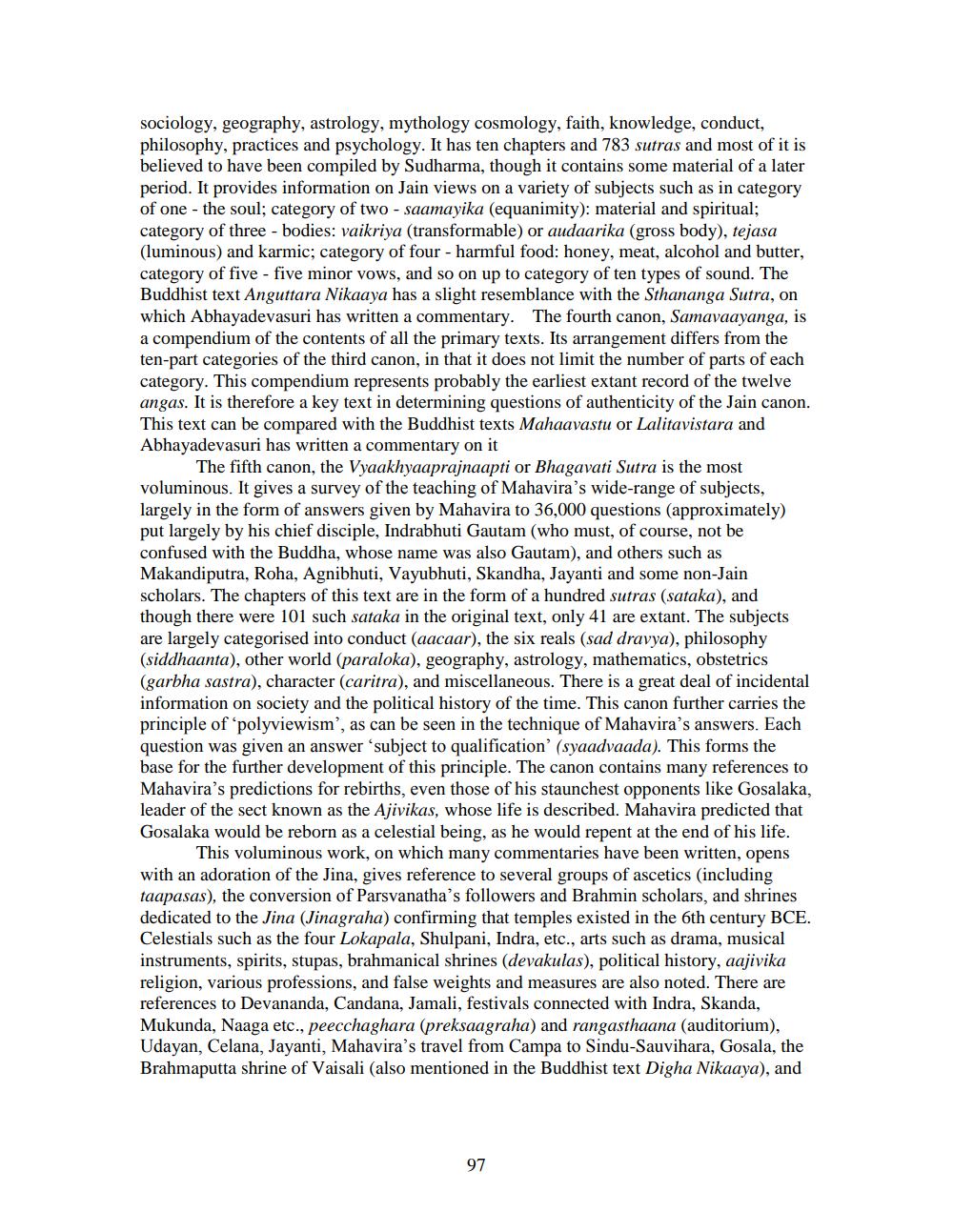________________
sociology, geography, astrology, mythology cosmology, faith, knowledge, conduct, philosophy, practices and psychology. It has ten chapters and 783 sutras and most of it is believed to have been compiled by Sudharma, though it contains some material of a later period. It provides information on Jain views on a variety of subjects such as in category of one - the soul; category of two - saamayika (equanimity): material and spiritual: category of three - bodies: vaikriya (transformable) or audaarika (gross body), tejasa (luminous) and karmic; category of four - harmful food: honey, meat, alcohol and butter, category of five - five minor vows, and so on up to category of ten types of sound. The Buddhist text Anguttara Nikaaya has a slight resemblance with the Sthananga Sutra, on which Abhayadevasuri has written a commentary. The fourth canon, Samavaayanga, is a compendium of the contents of all the primary texts. Its arrangement differs from the ten-part categories of the third canon, in that it does not limit the number of parts of each category. This compendium represents probably the earliest extant record of the twelve angas. It is therefore a key text in determining questions of authenticity of the Jain canon. This text can be compared with the Buddhist texts Mahaavastu or Lalitavistara and Abhayadevasuri has written a commentary on it
The fifth canon, the Vyaakhyaaprajnaapti or Bhagavati Sutra is the most voluminous. It gives a survey of the teaching of Mahavira's wide-range of subjects, largely in the form of answers given by Mahavira to 36,000 questions (approximately) put largely by his chief disciple, Indrabhuti Gautam (who must, of course, not be confused with the Buddha, whose name was also Gautam), and others such as Makandiputra, Roha, Agnibhuti, Vayubhuti, Skandha, Jayanti and some non-Jain scholars. The chapters of this text are in the form of a hundred sutras (sataka), and though there were 101 such sataka in the original text, only 41 are extant. The subjects are largely categorised into conduct (aacaar), the six reals (sad dravya), philosophy (siddhaanta), other world (paraloka), geography, astrology, mathematics, obstetrics (garbha sastra), character (caritra), and miscellaneous. There is a great deal of incidental information on society and the political history of the time. This canon further carries the principle of polyviewism', as can be seen in the technique of Mahavira's answers. Each question was given an answer 'subject to qualification' (syaadvaada). This forms the base for the further development of this principle. The canon contains many references to Mahavira's predictions for rebirths, even those of his staunchest opponents like Gosalaka, leader of the sect known as the Ajivikas, whose life is described. Mahavira predicted that Gosalaka would be reborn as a celestial being, as he would repent at the end of his life.
This voluminous work, on which many commentaries have been written, opens with an adoration of the Jina, gives reference to several groups of ascetics (including taapasas), the conversion of Parsvanatha's followers and Brahmin scholars, and shrines dedicated to the Jina (Jinagraha) confirming that temples existed in the 6th century BCE. Celestials such as the four Lokapala, Shulpani, Indra, etc., arts such as drama, musical instruments, spirits, stupas, brahmanical shrines (devakulas), political history, aajivika religion, various professions, and false weights and measures are also noted. There are references to Devananda, Candana, Jamali, festivals connected with Indra, Skanda, Mukunda, Naaga etc., peecchaghara (preksaagraha) and rangasthaana (auditorium), Udayan, Celana, Jayanti, Mahavira's travel from Campa to Sindu-Sauvihara, Gosala, the Brahmaputta shrine of Vaisali (also mentioned in the Buddhist text Digha Nikaaya), and
97




